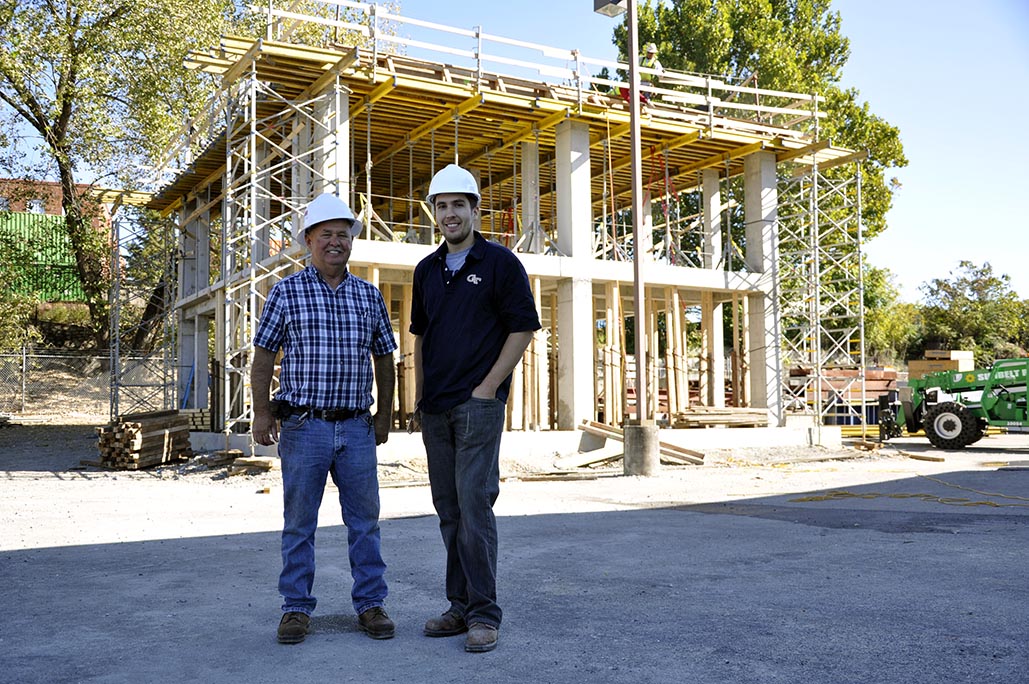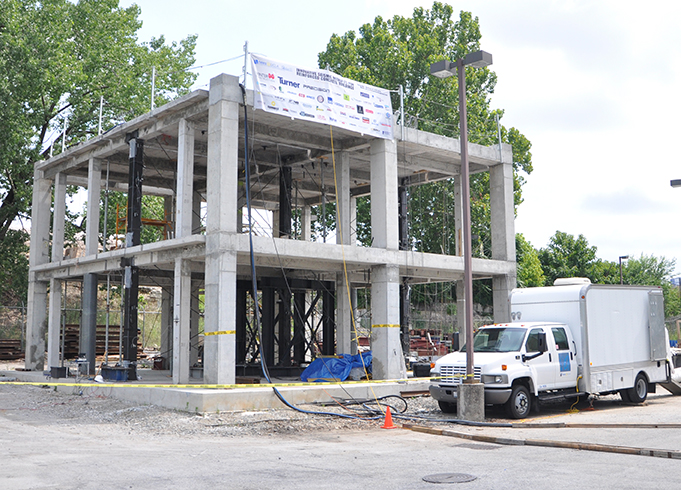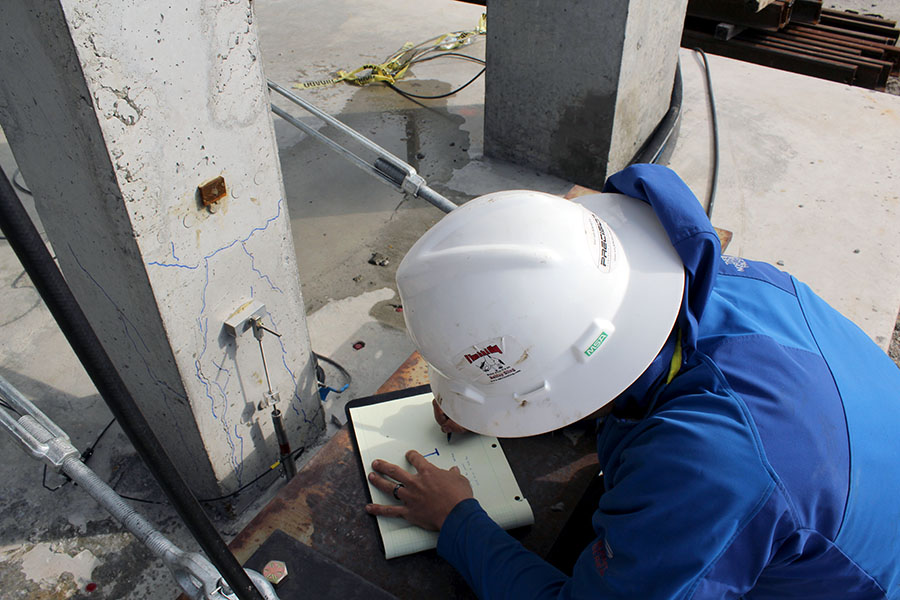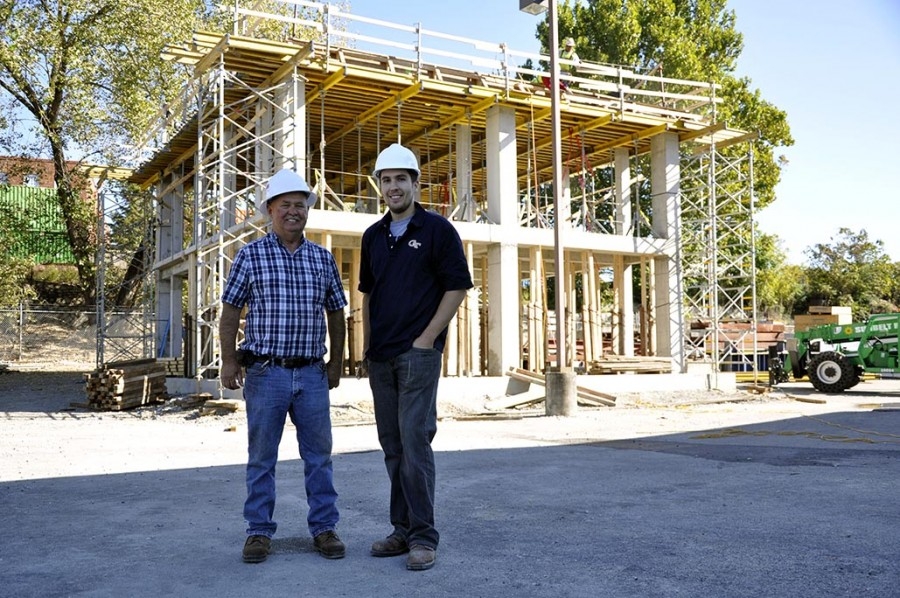 Ph.D. student Tim Wright, left, with project superintendent J.T. Mote in October 2013 as crews worked on the top-level decking for the test structure Wright designed. Wright's research involved shaking the building to near-failure to test seismic retrofitting techniques. More than 40 companies donated labor, materials and expertise to build the structure, including Mote's employer, Winter Construction. (Photo by Jess Hunt.) |
Tim Wright was about to abandon his Ph.D. studies.
He even met with his adviser and they agreed Wright would work on some other projects and finish his master’s degree.
| MORE COVERAGE: | |
|
|
|
|
|
|
|
|
|
Then he discovered what he really loved to do, and that changed everything.
Along the way, Wright learned a lot about engineering, of course, but he also learned about much more: public relations, marketing, raising donations and building relationships, project management, even event planning.
It’s all because Wright started working at the School of Civil and Environmental Engineering’s Structural Engineering and Materials Lab, where he realized experimental research fulfilled his need to get his hands dirty.
“I went back to [my adviser] and I said, ‘You know, I hate to flip-flop on you, but I’ve really enjoyed being out in the Structures Lab, and I think if we could find a project that is an experiment-based project, I really would like to stick around and do a Ph.D.,’” Wright said. “[I told him,] ‘I would just really like to do experimental research.’”
It was a discovery and a conversation that came at just the right time. Wright’s adviser, professor and School Chair Reginald DesRoches, had a big project lined up that took the idea of experimentation to the extreme. And he needed someone to run it.
Wright was the man for the job.
The project, funded by the National Science Foundation’s Network for Earthquake Engineering Simulation, would test innovative ways to retrofit a common type of reinforced concrete building to better withstand earthquakes. To do that, they needed an old building that they could partially destroy with a massive shaker, a device to simulate the effects of an earthquake.
So that was Wright’s first task: find a building constructed in this style common to the 1950s and ‘60s.
“It was daunting; it was a big task,” Wright said. “I mean, ‘go find a building.’ Where do you start?”
Daunting, in the end, might be an understatement. After nearly a year of scouring state and federal inventories, calling anyone he could think of, and even just driving around Atlanta, Wright couldn’t find something to fit the bill. By then, time was running out — the NSF had awarded the money, and the clock was ticking on conducting the experiments.
That’s where things got interesting. Wright and DesRoches decided if they couldn’t find a building, they’d build one. From scratch.
And then destroy it.
“OK, now we’ve got to build a building. Problem: We didn’t plan on building a building, so we don’t have money for it,” Wright said.
“So I designed a prototypical structure based on a 1950s, ‘60s, ‘70s time period reinforced concrete office building, a low-rise structure, two stories.”
 |
 |
| Left: In September 2013, Ph.D. researcher Tim Wright and project superintendent J.T. Mote look over plans for a two-story, reinforced-concrete test structure while workers prepare rebar in the the building's base. Right: The fully completed test structure just before the second round of experiments in July 2014. (Photos by Jess Hunt and Joshua Stewart.) | |
DesRoches tapped into the School’s broad alumni network to find out how much Wright’s design would cost. The researchers met with Brent Reid, B.S. 1982, CEO of Winter Construction in Atlanta, and Sam Carter, president of Carter Concrete Structures in Stone Mountain, Georgia.
“They said, we would love to help, but that’s way more than either of us could do on our own,” Wright said. “They came up with the idea, why don’t we try to get the Atlanta engineering community more broadly involved and break this up into palatable chunks.”
Now the question was: where do we put this giant structure? There was land available next to the School’s Structures Lab, but Georgia Tech’s facilities managers had understandable concerns.
“We [wanted to] intentionally build this crummy, older-designed building,” Wright said. “There were a whole bunch of people at Georgia Tech that were like, whoa hold on a sec. You’re building this thing that’s going to fail. Who has liability? Who has risk? What happens if someone gets hurt there?”
Ultimately, another Atlanta engineering firm stepped in to make the project happen. Jim Case, a principal of Uzun + Case and a licensed professional engineer, agreed to sign off on the building — with some significant caveats. But that was enough to get things moving.
In the end: 44 companies chipped in labor, materials and expertise to put together the nearly $200,000 test structure. And throughout 2014, Wright, other Georgia Tech researchers, and the mobile shaker team from University of California, Los Angeles, went through four sets of tests, bringing the building to the brink of failure to see how three different reinforcing retrofits performed.
 Tim Wright makes notes during a series of experiments on the two-story test structure in March 2014. (Photo Courtesy of Tim Wright.) |
“I did so much on this project that had nothing to do with engineering,” Wright said. “It was just like drinking from a fire hose, because I don’t have training in any of that kind of stuff. I don’t have training in PR, in executive summaries, or trying to sell products, or developing relationships, at least not in terms of soliciting donations.
“But a lot of the non-technical part — because I had never really been exposed to it — was really enjoyable for me.”
Wright is deep into sorting through mountains of data and writing his Ph.D. dissertation now, but he’s not done with his education. He starts the MBA program in the Scheller College of Business in the fall.
Wright said he hopes to use that experience, along with his engineering background, to become an entrepreneur. He wants to apply to the Scheller College’s TI:GER program, which matches a Ph.D. student with MBA students and Emory University law students to commercialize their Ph.D. research project.
Wright said he would bring unique value to a team since he’ll have an understanding of the engineering issues as well as the business ones. But it’s an opportunity he might not have had without his doctoral research experience.
“It really helps to look at a complex problem, break it down into its critical components so you can attack them individually and assemble it into a solution to whatever problem you had to begin with,” Wright said.
“I definitely learned a lot of skills, and I’ve been introduced to a lot of things,” he said. “I’ve been afforded enormous opportunities as a Ph.D. student that I wouldn’t have had otherwise.”



